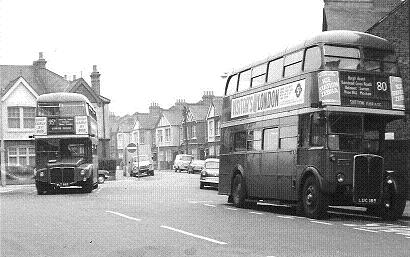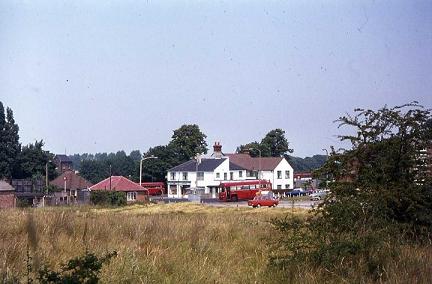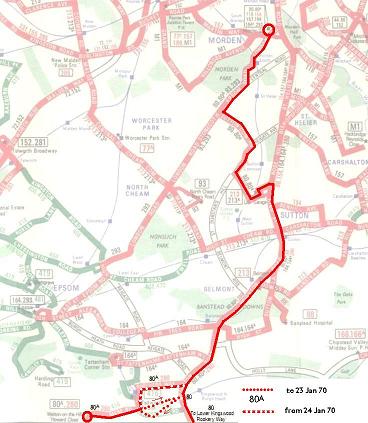|
|
Red RF routes
Routes 80 and 80A
Page last updated 14 November 2014
As one-man operation took
hold, a number of London Transport's RT routes were converted to RF
operation. Two early examples were the 80 and 80 A
in 1969, reintroducing RFs to Sutton garage after a gap of six
years. Sutton's RF era came to an end in 1976.
Here, RF448 is seen at the Chequers, Walton on the Hill, on the
last day of operation, 26 June 1976.
Photo © John Parkin
RFs returned to Sutton in 1969, six years after the
double-decking of the 213, for the OMO
conversion of RT routes 80 and 80 A.
Dates of RF operation
22 Mar 69 to 26 Jun 76
(total 7 years 3 months, all OMO)
Destinations
MORDEN STATION and
LOWER KINGSWOOD (80)
MORDEN STATION and WALTON-ON-THE-HILL
(80A)
Reason for single-deck operation
The 80 and 80A had always been double-deck operated
until converted to one-man operation in 1969, at which time only
single-deckers were available for OMO.

A 1960s shot at the Tooting Broadway
stand. RT4026 on the 80 meets a Brixton RM on the
95A.
Photo Ian Armstrong collection
Route history
The first buses over the road from Clapham Common to Lower
Kingswood via Tooting, Mitcham and Sutton were 'trips to the
country' on Sundays, from 1913. Running first as 115, then
(starting nearer central London) as 178 and finally 128,
the route (which operated in summertime only most years) was
finally integrated into route 80 in 1933.
Meanwhile, in July 1916, new weekday route 80 was introduced
from Clapham Common as far as Belmont
California, but was withdrawn after only two weeks.
It re-commenced operation in March 1919, running on weekdays
from Charing Cross via Clapham Common to Belmont and worked by
Merton Garage. In June 1920, an extension
numbered 80A was introduced to Lower Kingswood
Fox. The section south of Burgh Heath
was covered fitfully by either 80 and 80A for the
first year or so, but in January 1922 the 80A was
reintroduced, covering part of the the former Sutton to Kingswood
section of the 113, but diverted to run
to Walton-on-the-Hill. That May, the 80 reached Lower
Kingswood on weekdays, replacing the remainder of the former 113
route that had been unserved on weekdays.
Sutton Garage took over both routes in January 1924, at
which time the route was worked with K-types, and has operated
the 80 ever since. At the same time, both routes were
shortened to start at Clapham Common and diverted to run via
Banstead. The northern end was reinstated in April 1924 and
the diversion removed in April 1927 when the routes reverted to
using the main road. During the remainder of the 1920s, the
route used K, S and open-top NS types, with covered top NSs
replacing them at the end of 1930. For the Bassom era, 1924 to 1934, the
80A was renumbered 180, but reverted on the October 1934
renumbering.
 Rural Belmont, a short-working
destination, on the last day of RF operation. RF425 on stand,
while another passes. Rural Belmont, a short-working
destination, on the last day of RF operation. RF425 on stand,
while another passes.
Photo © John Parkin
In May 1930 as part of a major reorganisation of south London
services, the northern end of the routes was cut back to St Helier
and instead ran from Morden Station along the new St Helier
Avenue. In December 1931, the Lower Kingswood terminus was
moved from 'The Fox' to the forecourt of the 'Canada Hut Tea Rooms'
on the other side of the main road.
At around this time, there was a proposal to extend the 80
to Redhill and transfer both routes to London General Country
Services, presumably linked with alterations to the 406, but
this plan failed due to staff opposition at Sutton.
From January 1935, the allocations were merged into a joint
allocation of NSs; STLs also had brief Sunday allocations on the
routes in 1934 and 1935, after a brief period of Dennis Lance (DL)
working in 196-37, STLs took over full time.
After the outbreak of war, in November 1939, the northern
terminus was switched to Tooting, replacing the 88 between Mitcham
(St Helier in peak hours) and Belmont. Morden to Sutton was
well-covered by the 157 and 164. In March 1946, the 80 gained
a small extension from Canada Hut to the Mint Arms in Buckland
Lane, Lower Kingswood. The pre-war weekday joint allocation
of 8 buses increased progressively to 17 by the end of the war;
thereafter Saturdays were for some reason much busier, requiring 30
buses into the RT era. Utility Daimlers replaced STLs in
1946, lasting until RTLs took over during 1953 (briefly, soon
replaced by RTs when Sutton became an AEC garage during 1954;
Sutton was already operating RFs on the 213).
The 80A terminus remained at The Chequers,
but in November 1955 ceased to be on the forecourt, buses
instead running on to turn by reversing at Howard Close and
standing opposite The Chequers.
On the last day of RF operation on route
80A, 26 June 1976 (a hot dry
summer), RF427 lays over at Howard Close, Walton-on-the-Hill.
Photo © John
Parkin
The RTs plied the routes undisturbed for 15 years until a major
upheaval in 1969, when one-man RF operation arrived. On 22
March, the Mitcham to Sutton section was replaced by new RT
route 280 - which continued as far as Belmont, plus school
journeys all the way to Walton-on-the-Hill - and the 80
and 80 A were diverted to run from Morden via Sutton
Common Road, a section of route previously covered by the
213 A, whose workings between Sutton and Wimbledon were
withdrawn.
With the loss of a conductor to assist in the
turns, the 80 was shortened slightly in Buckland Lane, Lower
Kingswood, to use a new turning circle at Rookery Way and the
80A was extended in Walton-on-the-Hill to use a
new turning circle at Howard Close. Other small changes
made at the same time included dropping the small detour to pass
Belmont Station and (on the 80A) introducing a diversion
to serve Tadworth Station.
By 1969, there were quite a number of spare
RFs in store, some having not been used for three years. It
was from this stock that Sutton's allocation was drawn, including
the two buses that had been allocated to Potters Bar for the
284.
Since 1922, the 80A had omitted properly to serve
Tadworth, running in via New Road and back along Tadworth
Street. Shortly after the introduction of the RFs, on 24 Jan
70, this was finally rectified and the route was diverted in both
directions to run via Shelvers Way and Tadworth Station.
Nothing changed in the difficult years of the
early 70s, the RFs continuing to perform well. The routes
were finally converted to Bristol BLs in June 1976. A few
months later, the weekday operations on the 80 were shortened to
Belmont and replaced further south by the 280, whilst weekday
operations on the 80A were replaced entirely by the new
280A, running over the old RT route 80A from
Tooting Broadway.
The Sunday-only 80 A staggered on for a few more
years, including rerouting to cover part of the withdrawn 164A and conversion to DMS in 1979,
but both it and the 280 A were withdrawn in
1982.
 The 80 reverted to double-deck (DMS) operation in
1979 (Sunday) and 1982 (weekdays), going through a number of
changes, including a spell covering the 93 to Putney Bridge, before
reverting to single-deck in 1996 when it was extended from Morden
to Hackbridge Reynolds Close, a section of route with
a chequered history since its original wartime introduction as
the 151.
The 80 continues today to run from Belmont to Morden and on to
Hackbridge. Lower Kingswood and Walton-on-the-Hill are
however only served by Surrey routes, with Metrobus's 420 running
from Reigate to Sutton and their 460, the replacement for
country route 406, running to Epsom via both Lower Kingswood and
Walton.
Bus map 1972 © London
Transport
RF route in detail, with timing points
80:
MORDEN STATION, London Road, Epsom Road, Sutton Common Road,
Sutton Common Road
Woodstock, Oldfields Road (A217), Collingwood Road,
Bushey Road, Sutton Garage,
High Street Sutton, Sutton
Cock, Brighton Road, Belmont Station, Brighton Road,
Banstead Crossroads,
Brighton Road, Burgh Heath
Reigate Road, Brighton Road, Lower Kingswood Fox, Buckland
Lane, LOWER KINGSWOOD Rookery
Way
80A:
To 23 Jan 70: MORDEN STATION, London Road, Epsom Road,
Sutton Common Road
Woodstock, Oldfields Road (A217), Collingwood Road,
Bushey Road, Sutton Garage,
High Street Sutton, Sutton
Cock, Brighton Road, Belmont Station, Brighton Road,
Banstead Crossroads, Brighton
Road, Burgh Heath Reigate
Road, Brighton Road, Dorking Road, New Road
(return to Brighton Road via Tadworth Street), Mere Road, Walton
Street, Chequers Lane, WALTON ON THE HILL Howard Close
From 24 Jan 70: MORDEN STATION, London Road, Epsom Road,
Sutton Common Road
Woodstock, Oldfields Road (A217), Collingwood Road,
Bushey Road, Sutton Garage,
High Street Sutton, Sutton
Cock, Brighton Road, Belmont Station, Brighton Road,
Banstead Crossroads, Brighton
Road, Burgh Heath Reigate
Road, Brighton Road, Shelvers Way, Ashurst Road, Cross
Road, Tadworth Station,
Station Approach Road, Tadworth Street, Mere Road, Walton Street,
Chequers Lane, WALTON ON THE HILL Howard Close
Frequency
Throughout RF operation:
| Route 80 |
15-30 mins |
24-30 mins |
60 mins |
| Route 80A |
15-30 mins |
24-30 mins |
60 mins |
RF allocation
PVR (joint, throughout): Mon-Fri 10, Sat 12, Sun 5
Parallel lines: RF444 and
RM1000 serve the southbound stop at Belmont California
during our Carshalton Running Day in 2007.
Photo ©
Richard Thomas
|
|